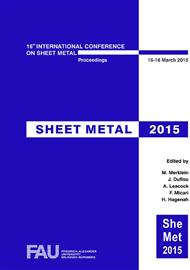p.395
p.403
p.411
p.419
p.427
p.435
p.443
p.451
p.459
Enhancement of Lemaitre Model to Predict Cracks at Low and Negative Triaxialities in Sheet Metal Forming
Abstract:
Advanced high strength steels are still one of the best alternatives for light weight design in the automotive industry. Due to their good performances like high strength and high energy absorption, those steel grades are excellent for body in white components. Because of their restricted ductility, which sometimes leads to the formation of cracks without or low necking during forming operations, conventional forming limit diagrams may fall short. As a remedy, an enhanced variant of the Lemaitre continuum mechanical damage model (CDM) is presented in this work.Previous model extensions of the Lemaitre model improved the damage prediction for the shear and compression dominated stress states by introducing an additional weighting factor for the influence of compression on damage evolution, the so called crack closure parameter h. However, the possible range of the fracture behavior predicted by such models for low and negative stress triaxialities is limited. In this work, the Lemaitre CDM has been enhanced by considering the maximal shear stress to predict the fracture occurrence under shear. Previous models for the effect of void closure on damage evolution are reviewed and a novel model enhancement taking into account the maximal shear stresses is described. The determination of the damage model parameters is presented for a dual phase steel. For this particular material, the response of model enhancement on the failure prediction is discussed for a test part.
Info:
Periodical:
Pages:
427-434
Citation:
Online since:
March 2015
Authors:
Price:
Сopyright:
© 2015 Trans Tech Publications Ltd. All Rights Reserved
Share:
Citation:


